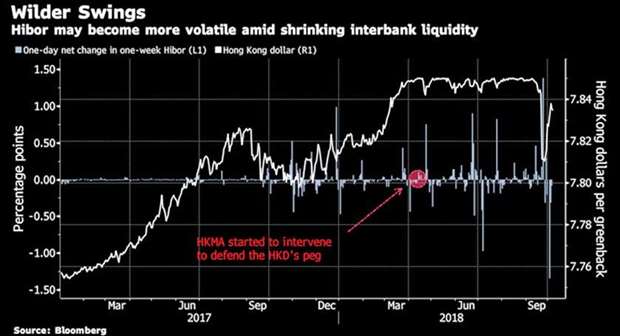Prepare for even greater swings in the Hong Kong dollar and funding costs in the city, as a shrinking pool of liquidity amplifies moves in interest rates.
Hong Kong’s one-week interbank borrowing cost rose the most in a decade on September 24 amid a surge in quarter-end demand for loans by banks, then tumbled by a similar magnitude.
The city’s aggregate balance has more than halved over six months due to official intervention in the foreign-exchange market as the gap between local and US rates made the Hong Kong dollar a target to short – an issue likely to persist as the Federal Reserve tightens further.
A currency peg with the dollar means Hong Kong is tied to US monetary policy. After the Fed hike last week, local banks including HSBC Holdings raised their prime lending rates for the first time since 2006. Ultra-low borrowing costs fuelled inflows into the city’s assets over the past decade, turning Hong Kong into one of the world’s least affordable property markets.
“We may see sudden spikes in Hibor and the Hong Kong dollar more often in the future, as the seizable drop in aggregate balance has made banks more concerned with liquidity shortage,” OCBC Wing Hang Bank economist Carie Li said, using the term for Hong Kong interbank rates. “Higher volatility in borrowing costs could dent confidence, with local lenders turning more cautious when making loans and investments in the property market.” Treasury yields are rising on signs of economic strength in the US, with traders now pricing in more than two Fed hikes for 2019. Benchmark 10-year yields topped 3.20% on Thursday for the first time since 2011, while assets declined in Hong Kong.
The Hang Seng Index – already rocked by the trade war – lost 0.2% on Friday, extending this week’s decline to 4.4%. The offshore yuan dropped 0.1%, while the Hong Kong dollar gained 0.02% to HK$7.8337 on Friday.
Risk of occasional tightness in funding suggests Hong Kong dollar trades may become more tactical and sensitive to events that raise demand for funds, such as month- and quarter-ends, public holidays, initial public offerings and irregular, large purchases of the currency, Bank of America Merrill Lynch strategist Ronald Man wrote in a note dated October 3.
Swings in Hibor shook the usually docile Hong Kong dollar late last month: the currency followed its biggest daily gain in 15 years with its worst weekly slide since January 2016. That came as the aggregate balance hit the lowest since late 2008.
Hong Kong’s de facto central bank intervened repeatedly since April to stop the currency falling beyond the weak end of its trading band.
Interbank liquidity has shrunk to a level that will lead to more volatility rather than a sustained increase in funding costs, said Eddie Cheung, Asia foreign-exchange strategist at Standard Chartered. In the near term, Hibor will likely drop from highs seen last month, which may bring back some short Hong Kong dollar positions, he said.

GULF TIMES


